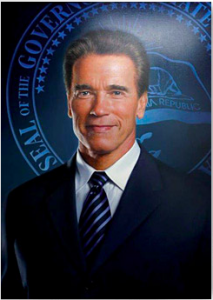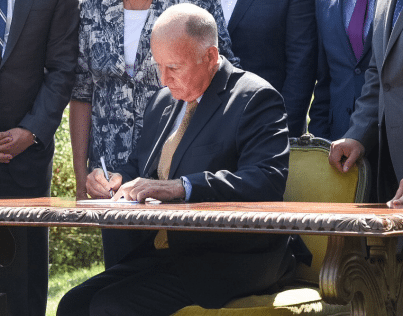
California State Capitol (Photo: Kevin Sanders for California Globe)
How Voters Can Transform California in One Election
Ten bipartisan state ballot propositions to consider to fundamentally transform California
By Edward Ring, May 13, 2019 6:04 am
Oxnard, California, wouldn’t immediately come to mind as the epicenter of a political revolution, but that’s exactly what it will be, if a small group of citizen activists succeed in putting not one, but five reforms in front of voters in the next major election.
The citizens initiative has been available to Californians at the state and local level for decades, but they are relatively unusual in local elections, and typically come one at a time. Local activists in San Jose and San Diego, for example, both placed pension reform initiatives on their municipal ballots, which voters passed by by landslide margins.
But what’s happening in Oxnard is unique, because voters may have the chance to vote on an entire slate of initiatives. While each one addresses a different topic of reform – financial transparency, street maintenance, term limits, open meetings, and permit streamlining – if voters approved all of them, they would have a mutually reinforcing impact. They would transform local politics in Oxnard forever, and pave the way to even bigger reforms.
What happened to California?

At the state level, a slate of initiatives was tried in 2005 by then Governor Arnold Schwarzenegger. Taking office in Nov. 2003, Schwarzenegger tried for over a year to get California’s legislature to implement the reforms that voters had apparently mandated when they recalled the previous governor, Gray Davis. Unfortunately, Schwarzenegger’s initiatives had no viable campaign. Tepid variants of “it’s gone too far” doused the airwaves, barely, while the opposition went into beast mode. Government union professionals spent well over $100 million on a bare knuckles campaign that characterized Schwarzenegger as a man who wanted to kick firefighter widows into homeless camps, and force teachers to live on food stamps.
Meanwhile, California’s Republican party, already well on its way to imploding, along with nearly every Republican officeholder, stood on the sidelines and kept their heads down. No wonder Schwarzenegger turned into a quasi-Democrat, but that’s another story.
Imagine what California would have been like if every one of these initiatives – an extended waiting period for teacher tenure, paycheck protection, a balanced budget, and redistricting reform – along with the initiative the consultants talked Schwarzenegger out of introducing, pension reform – had been passed by California’s voters. It would be a different state today.
There is no reason, however, why this can’t be tried again. And there are people who can make it happen.
According to Forbes Magazine, there are 158 billionaires living in California. It still only costs, at most, about $5 million to get an initiative qualified for the California ballot, maybe a bit less if you’re qualifying several all at once. Figure $50 million to get ten initiatives onto the ballot, and another $50 million to wage a campaign promoting all of them at once – economies of scale.
There are 158 people in California who could do this while spending less than 10 percent of their net worth. Would you spend ten percent of your net worth to have a shot, a very real shot, at transforming California completely? Is there even one person among California’s 158 super-rich, just one person who is willing to challenge the feudal oligarchy that controls California in partnership with public sector unions and the “environmentalist” clerisy?
Here are some suggestions.
Transforming California – Ten Bipartisan State Ballot Initiatives
(1) Nuclear Power Development: California’s government will use all its powers to promote nuclear power. It will recommission San Onofre nuclear power station and construct additional reactors. It will cancel the planned decommissioning of Diablo Canyon nuclear power station and construct additional reactors. It will solicit bids for public/private financing of additional nuclear power capacity with a goal of increasing total California based nuclear power output from the current 2.1 gigawatts to at least 10 gigawatts. The state attorney general will aggressively litigate in support of fast tracking approval and construction of these projects.
(2) Renewables Pricing Reform: California will require renewable electricity suppliers to include in their pricing the costs for them to deliver reliable continuous power 24 hours per day, 365 days per year, and lower its renewable portfolio mandate to 20 percent until renewables are competitive with other forms of energy using this new pricing model.
(3) Redirect High Speed Rail Funds: The high speed rail project will be cancelled. Any remaining funds will be allocated to upgrades of existing rail to facilitate faster (120 MPH) speeds on existing inter-city rail corridors.
(4) Water Infrastructure Funding: California will issue general obligation bonds in the sum of $30 billion to accomplish the following specific projects: (a) $3.0 billion for the Sites Reservoir (supplementing funds already granted) with storage capacity of 2.0 million acre feet (MAF), (b) $3.0 billion for the Temperance Flat Reservoir with storage capacity of 1.0 MAF, (c) $7.5 billion for desalination plants on the California coast with annual capacity of 0.5 MAF, (d) $7.5 billion to retrofit urban water treatment plants statewide to potable standards with annual reuse capacity of 1.0 MAF, (e) $4.0 billion to retrofit existing aqueducts with priority on the Friant/Kern canal, (f) $5.0 billion for seismic retrofits to levees statewide, with a focus on the Delta. The timeline for submittal of proposals and awarding of funds shall not exceed 12 months. The state attorney general will aggressively litigate in support of fast tracking approval and construction of these projects.
(5) Additional Highway Funding: California will issue general obligation bonds in the sum of 30 billion to upgrade and add lanes to every major freeway in the state. Priority shall be granted to construction of high speed lanes and smart lanes. These funds will supplement funds already awarded for road construction. The timeline for submittal of proposals and awarding of funds shall not exceed 12 months. The state attorney general will aggressively litigate in support of fast tracking approval and construction of these projects.
(6) CEQA Reform: California’s Environmental Quality Act of 1970, “CEQA,” will be modified as follows: (a) duplicative lawsuits shall be prohibited, (b) all entities that file CEQA lawsuits will be required to fully disclose their identities and their environmental or non-environmental interest, (c) court rules that still enable delaying tactics will be illegal, (d) rulings that stop entire projects on a single issue will be prohibited, (d) the loser in CEQA litigation will be liable for legal fees.
(7) Pension Benefit Reform: The California constitution will be amended to eliminate the so-called “California Rule,” which allegedly prohibits modification to pension benefit accruals for future work. Pension benefits for state and local employees, for future work, shall revert to rates of accrual that were in effect in 1998.
(8) Pension Funds Infrastructure Investment: California’s state and local government employee pension funds shall be required to invest a minimum of 10 percent of their assets in general obligation bonds. These investments shall be limited to infrastructure bonds issued by the state to fund water or transportation infrastructure.
(9) K-12 Tenure, Layoff, Dismissal Policies: California teachers will be required to complete a minimum of five years of classroom teaching prior to being granted tenure. School principals shall have sole authority over what teachers may be subject to layoff, in order to allow merit instead of seniority to govern layoff decisions. The process for dismissing incompetent or ineffective teachers shall be streamlined.
(10) Charter Schools: The right of nonprofit institutions to open charter public schools shall not be infringed; no limit shall be set on the number of charter schools. Charter school approval shall be binding based on any one of the following agencies granting approval – the local school district board, the local county board of education, or the California Dept. of Education.
These initiatives, if passed, would fundamentally change California. Moreover, these are not terribly controversial. There is growing bipartisan support for all of these, and the case for these initiatives with ordinary Californians would be very strong.
Honorable Mentions to Consider
Missing from this list but worth mentioning are somewhat more contentious possibilities: Repeal SB 375 to make it much easier to construct new housing across the state. Permit oil and gas drilling on the Monterey Shale formation and elsewhere within the state. Fast-track an oil pipeline into California to eliminate dangerous rail transport of nearly a half-million BBL per day into California, and augment that with an oil and gas import/export terminal on the California coast. Outlaw mandated project labor agreements on all public works projects. Begin to purge California’s higher education of its institutionalized racism and sexism by firing all “diversity, equity, and inclusion” officers in the UC and CalState systems, along with the expensive bureaucracies under them. Mandate colorblind and gender blind SAT scores once again become the top criteria for public college and university admissions.
There’s much more. The point in mentioning these more contentious possibilities is to provide a right-of-center contrast to the ten initiatives recommended above. These ten explicitly proposed initiatives are centrist. They are politically viable. They could all pass, if Californians had a chance to vote on them. How can you make a case against clean energy, abundant water, practical, next generation transportation, CEQA reform, pension reform, a new source of infrastructure financing, and quality education at last?
It is indeed possible to fundamentally transform California. Every election cycle, government unions and leftist oligarchs use their wealth to throw up self-serving state ballot initiatives, and the taxpayer organizations find themselves playing defense. It is time for some wealthy Californian who cares about the future of their state to step up, throw down, and go big. Don’t sponsor one initiative. Sponsor ten of them. Get them on the ballot. Then when it’s time to campaign, play to win.
For those aroused citizens who don’t happen to be billionaires, look to Oxnard; David’s sling is today’s local ballot initiative, and voters are the stone.
- Ringside: Quantifying California’s Brave EV Future - July 25, 2024
- Ringside: California’s Water Economy – The Three Biggest Choices - July 18, 2024
- Ringside: An Overview of California’s Water Economy - July 13, 2024





This article represents exactly why none of this will ever happen. Each suggestion further entrenches government agencies. None represent more freedom, you know, Article 1, Section 1 of the California Constitution.
The most amusing reference is to “taxpayer organizations … playing defense.” What taxpayer organizations would those be? Do they really represent you and me (the ultimate taxpayer is always the individual)? Once established, just like governments, organizations’ primary mission is continuing the status quo — survival.
Has the author called any of the 158 billionaires? What’s the pitch? Wouldn’t each one have their own ideas to implement? Witness John Cox and his Neighborhood Legislature initiative.
Why would anyone spend $100 million for more government? Unless of course it benefits them.
The suggestions are neither individually nor cumulatively are transformative. They dither around the edges of problems that go much deeper.
The so-called centrists won’t see much to get excited about. The suggestions are technocratic, the bailiwick of policy wonks, and not emotional or impactful at the individual level. Generations of government-schooled voters can be easily swayed by emotional appeals. Even the author’s philosophical cronies would likely not agree on the various implementations. The devil is in the details. Will they be written by lawyers who are the ultimate beneficiaries of almost all laws?
Meanwhile, government employees will work tirelessly and ceaselessly to avoid anything that doesn’t serve their self-interest. Witness Proposition 218, along with the gas tax and open records amendments to the California Constitution.
Typically, and there’s no indication that these suggestions aren’t typical, there will be no sanctions, after due process, of course, for non-compliance. Even then, those granted authority to enforce sanctions, have the discretion to ignore them.
Oxnard is a unique situation. The entire set of proposals are driven and funded by a single individual. Some, like term limits, are mundane and likely to pass without a campaign, if they make it to the ballot. None of the measures have sanctions, which means endless enforcement actions by private parties, just like the last measure that that same individual got passed.
A wise man once said, a law without a sanction is just a suggestion.
Change starts with individual human action, not talk and speculation. The hope lies in individuals who are not yet frozen into inaction by fear of retaliation. The individual in Oxnard may succeed. That success doesn’t transfer to others or to groups. That individual is taking action. What action have the rest of you taken?